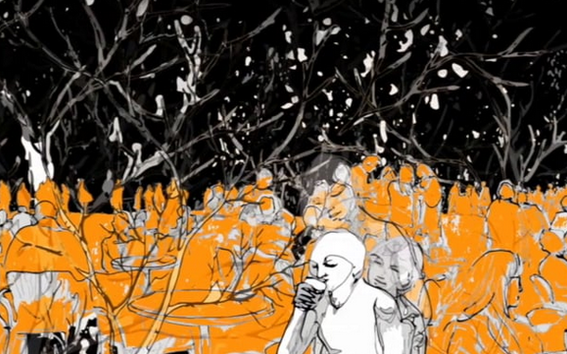Exploring a new medium for storytelling

Otaniemi Walks is a Master’s thesis and an interactive 3D storytelling debut by Elisa Andretti. Andretti’s thesis was set to find out “Which are the processes capable of turning Otaniemi into Finland’s leading sustainable campus by 2020?” The end product was a facilitating tool in the form of a visual story for different players in the process to find a common ground.
Every time a new medium of expression and storytelling emerges, there is a space of possibilities, an unknown terrain. The first works in this medium are explorations to that space. No conventions or best practices bind the artist - rhythms, language and functions are free for experimentation.
This is one way to approach Elisa Andretti’s Master’s thesis, Otaniemi Walks. It is one of the first works of immersive 3D storytelling. Elisa Andretti starts by describing the built heritage and current situation of Otaniemi. There are big changes looming just around the corner this monument of Finnish architectural history. The establishment of the Aalto University campus in Otaniemi continues. The metro will start operating in just two years. Instead of generating a new vision or plan to guide the process towards sustainability leadership, Andretti takes a different role. She offers a facilitative tool in the form of a story and common experience.
Sustainability is discussed from many angles in the textual part of the thesis. Andretti states that the term has evolved during times. It has been used in different fields and contexts. One of the points of view to sustainability is systems thinking. It is argued that one can’t change the system, unless one fully understands how the system functions. Instead, a sustainable way to handle a system is nurturing change. This means learning to know Otaniemi and nurturing the seeds that the environment offers. In other words, building on something that already resides in the system.
The thesis text provides a good starting point for getting to know the system in question. It offers an interesting story on Otaniemi as a built environment. Alvar Aalto’s original plan for Otaniemi entailed a pedestrian experience: a walk from the University to the sea shore. The plan had to be altered to cater for car traffic. Parking lots and tarmac roads disrupted the original vision of movement and space.
Another important theme emerges from the interviews of the stakeholders of the Otaniemi area. That is the presence of nature in Otaniemi. Apart from nurturing, creating common ground is important when managing a system sustainably. One conclusive suggestion of the thesis is that the nature of Otaniemi could function as such ground.
More material regarding the area is gathered through personal observation:
“Coming uphill from the coast, between Dipoli and Otakaari, there was a strip of small rowans, paired in a way to create a passage for one person, with a low ceiling of branches; it felt much more architectural than the carparks all around.” (Andretti, 2014: 71)
The voices from the interviews, theory and observations are weaved into a story for a 3D immersive environment. The work is an animation based on hand drawn sketches. The choice of the method is deliberate. Hand drawing aims to keep focus on atmosphere and main themes. Too much realism could invite shallow conflicts by pointing the discussion to details instead of themes. This would also diminish the role of participator to a mere viewer.
To function as a facilitation tool, the work is meant to be experienced and reflected upon together. An experiment run was conducted in ABE 21st October. A group of people from Otaniemi and elsewhere viewed the work and reflected upon it by discussing and writing. The work resonated with the audience in interesting ways, which are also described in the thesis text.
On the last pages of the thesis, Andretti reveals an important piece of inspiration. She recounts an experience from a studio course in Tanzania:
“Before they start a gathering, they sing together, and their songs are not just songs. There is a purpose, they sing to build a vision. Those songs are about politics, about society: they are songs about what they are going to do together.” (Andretti, 2014: 97)






